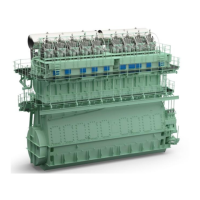Operation
0320−1/A1
Winterthur Gas & Diesel Ltd.
1/ 3
Procedures after Engine Stop
1. Procedures for Short Service Breaks (some days to
some weeks)
1.1 Engine is Maneuverable
If the engine must still be maneuvered after it has stopped, see the conditions that
follow:
D The WECS−9520 must stay set to on.
D All the pumps for coolant water, lubricating oil and fuel must operate.
D Control air must be available and the starting air bottles must be full.
D The cylinder cooling water must be kept at the correct temperature.
D Do not cool the lubricating oil.
D The fuel must be kept at the applicable temperature in accordance with the
0710−1 Viscosity-Temperature Diagram.
Note: Post-lubrication of the cylinders starts automatically during the decrease
of engine speed (below 8%).
1.2 Engine is Not Maneuverable
If the engine is not maneuverable, see the conditions that follow:
D After the engine has stopped, the coolant water and lubricating oil pumps must
operate for a minimum of 20 minutes to let the temperatures become stable. Do
not let these media cool below their usual inlet temperatures. The sea-water
pump can, thus, usually be stopped immediately.
D If the engine was shut down during operation with HFO, then the supply must
flow through the fuel pumps and the fuel rail. The fuel system must continue to
operate.
D The fuel pipe heating system of the engine must be set to on. If this is not
necessary, change the engine operation to diesel oil before shut-down (see
0270−1 Change-over from heavy fuel oil to diesel oil and 0620−1 Procedures
before Putting Out of Service for a Long Period).
D The low pressure feed pump and booster pump can be stopped, if the engine
was shut down during operation with diesel oil (see 0720−1 Fuel Treatment and
Fuel Oil System).
D Where possible, keep the cooling water warm to prevent the engine from cooling
down too much. The cooling water pump thus, continues to operate unless it is
necessary to stop the pump for maintenance.
2014
Engine Shutdown

